If you are a fan of the famous stuffed sweet flatbread Puran Poli of Maharashtra, then you must not miss trying this Bobbatlu Recipe too – a similar delicacy from the South Indian state of Andhra Pradesh. While this name is how it is known as in various regions of Andhra, it is also popular as the Obbattu Recipe or Holige Recipe in Karnataka. This delicious South Indian style flatbread is stuffed with a sweet, cardamom scented filling made of chana dal or tuvar dal. It is common during festivals like Ugadi, Ganesh Chaturthi and Gudi Padwa. Also, a favorite Diwali Sweet too.
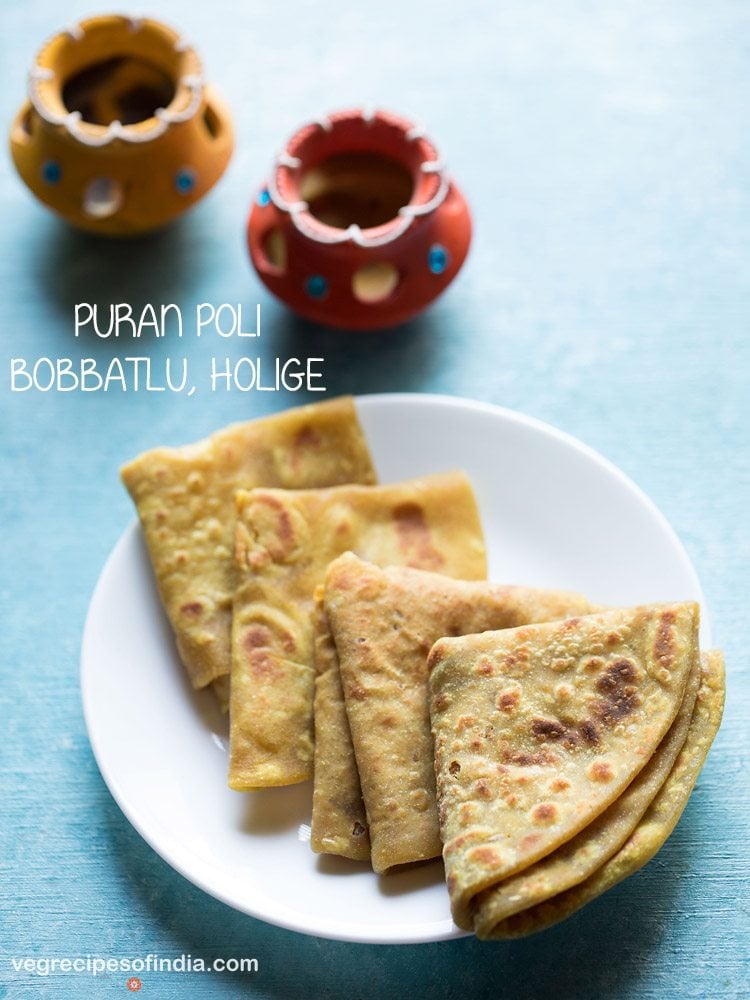
About Bobbatlu Recipe
As I mentioned in the beginning, since these yummy sweet flatbreads majorly belong to cuisines of Andhra Pradesh and Karnataka, so it is the Bobbatlu Recipe in Telugu language while Obbattu Recipe and Holige Recipe is what is commonly referred to in Kannada language. A similar variation becomes the Puran Poli of Maharashtrian cuisine.
For the Bobbatlu Recipe, usually all-purpose flour or maida is used to make the outer covering. This results in a thinner flatbread. Although in this Obbattu Recipe, I have used half-half of both all-purpose flour and whole wheat flour (atta). Also, this Holige Recipe is different from this Puran Poli recipe that I have shared on my blog.
Other ingredients that I add for the dough of the Bobbatlu Recipe are oil or ghee, turmeric powder, salt and water. The turmeric is what imparts a prominent yellow hue to this Holige Recipe. If you are not that fond of it, then you can give it a miss too. But then this Obbattu Recipe won’t be an authentic one.
Table of Contents
For the stuffing of this classic South Indian sweet flatbread, I have used split, husked Bengal gram (chana dal), jaggery, cardamom powder and nutmeg powder. You can even prepare the stuffing with split, husked pigeon pea lentils (tuvar dal) and give the nutmeg a miss, in case you don’t have it at home.
Tips For Perfect Obbattu
One of the best Bobbatlu Recipe is that of my aunt. The first time she visited use is when I got accustomed to her Obbattu Recipe. She had made lovely, decadent flatbreads and her Holige Recipe is what I follow till today.
She had also shared her knowledge on the know-how to make the most perfectly delish South Indian sweet flatbreads. Here are some of those for you to refer:
- The dough has to be kneaded very well. It should be like elastic and soft.
- For rolling, use finely ground rice flour as it helps in rolling evenly and thin, without breaking the flatbreads.
- Some cream of wheat (rava or suji) can be added to the dough.
- The more oil in the dough, the better is the texture of the dough.
- Chana dal has to be cooked well and ground well. If there are specks of whole chana dal in the ground stuffing, then the flatbreads can break while rolling.
- If the chana dal is slightly under cooked, then the jaggery becomes hard when the mixture is cooked.
- Do not overcook or brown the flatbreads too much, as then they become dense and hard.
- According to my aunt, it is best to have puran yantra. If you do not have puran yantra, then the next best option is a mixer or grinder. If you make these flatbreads often, then consider buying a puran yantra.
Like I said earlier, this recipe gives you tastiest flatbreads. Also, preparing these typical South Indian flatbreads does take a lot of time. So, do plan and organize your time and activities before making them.
How to make Bobbatlu Recipe
Make Dough
1. In a sieve, take 1 cup whole wheat flour, 1 cup all-purpose flour (maida), ¼ teaspoon turmeric powder and ½ teaspoon salt.
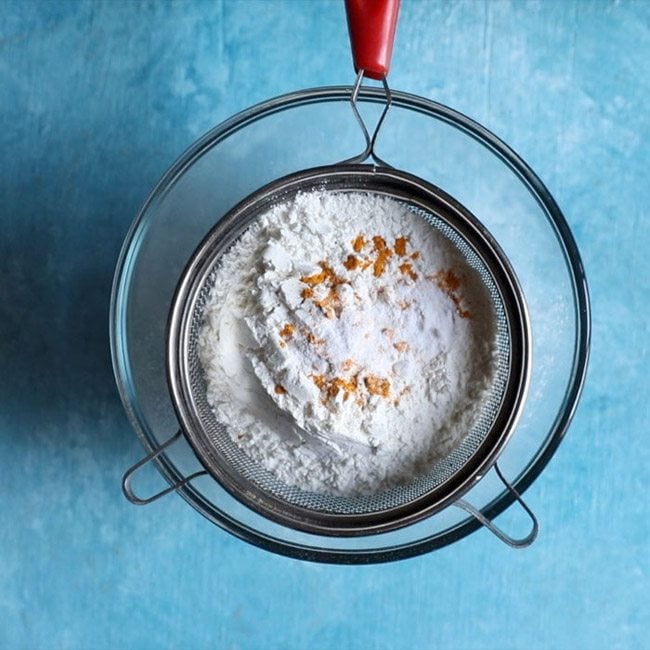
2. Sift and keep aside.
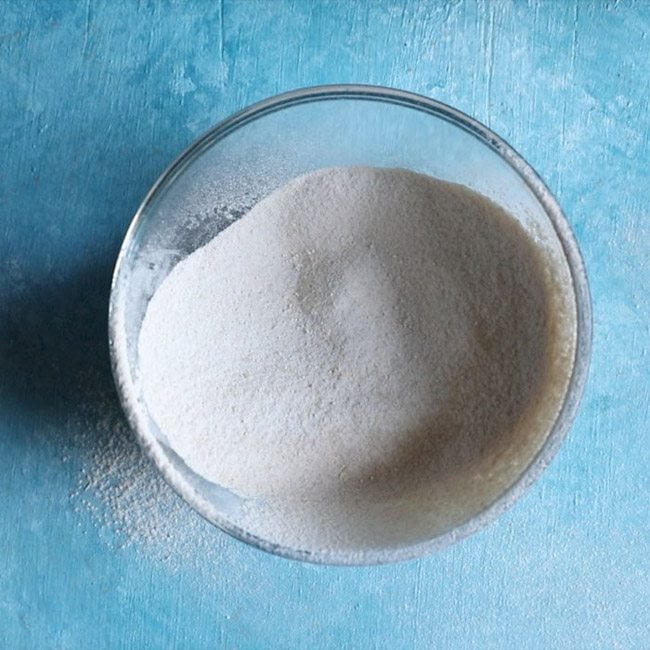
3. Add about ⅓ cup water.
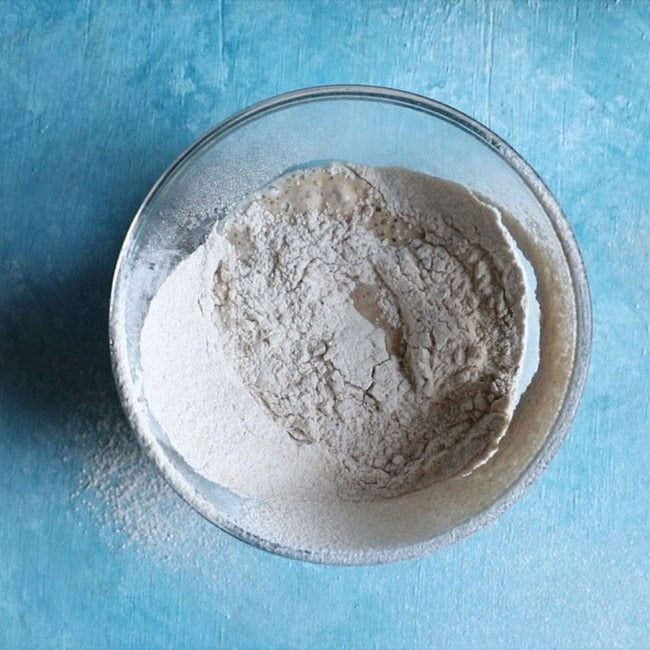
4. Knead lightly. Add water as required while kneading.
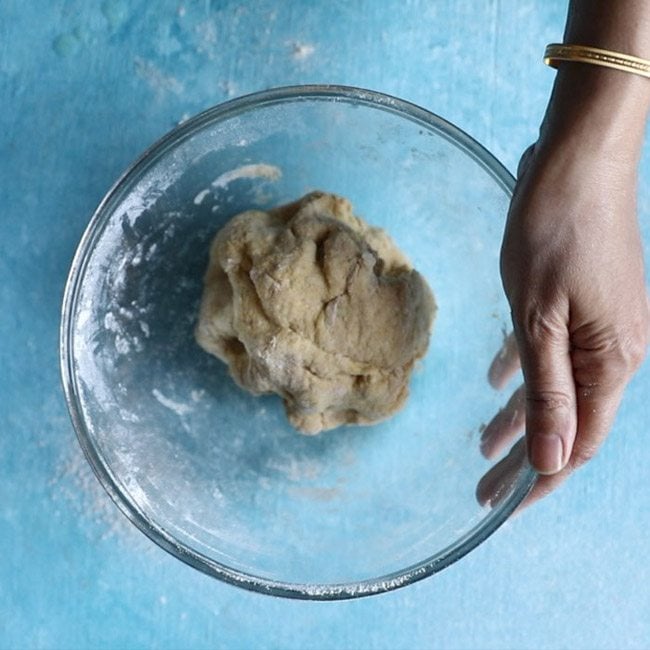
5. Next, add 5 tablespoons oil and continue to knead.
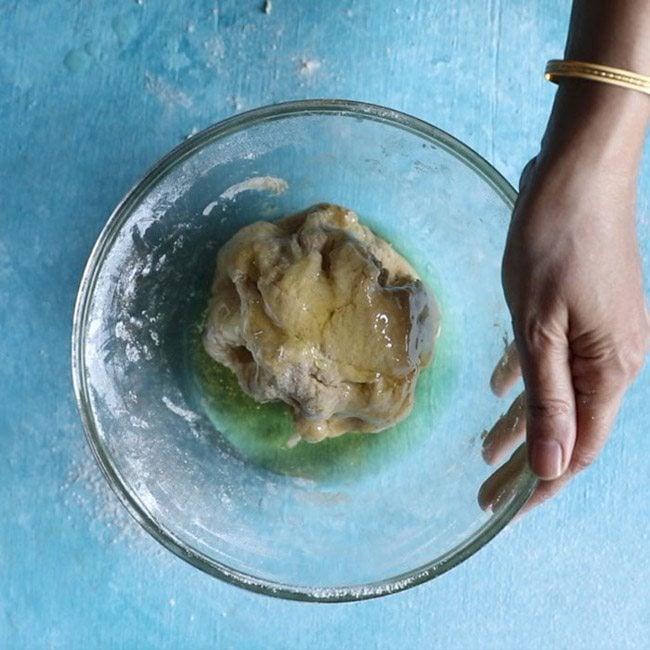
6. Knead till all the oil is absorbed. Basically, you will have to knead for about 7 to 8 minutes or till all the oil is absorbed and the dough becomes very soft and pliable.
Add more water, if required.
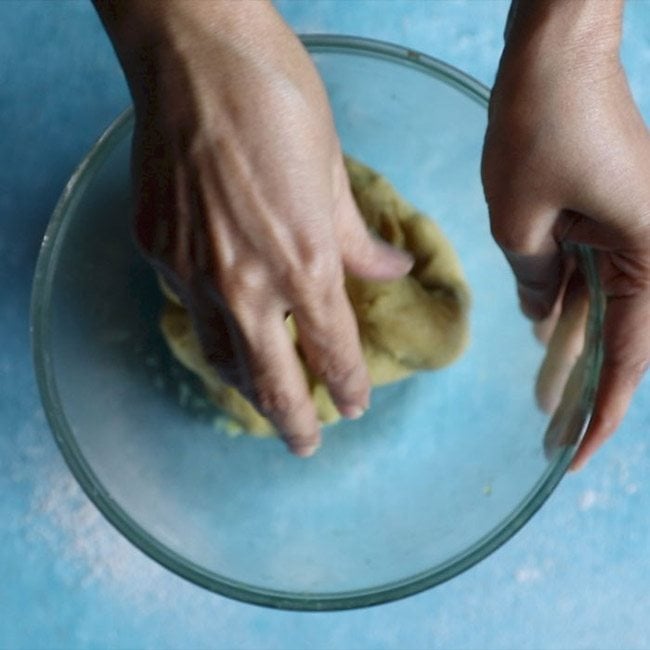
7. The dough should be kneaded very well to get a smooth, soft and elastic texture.
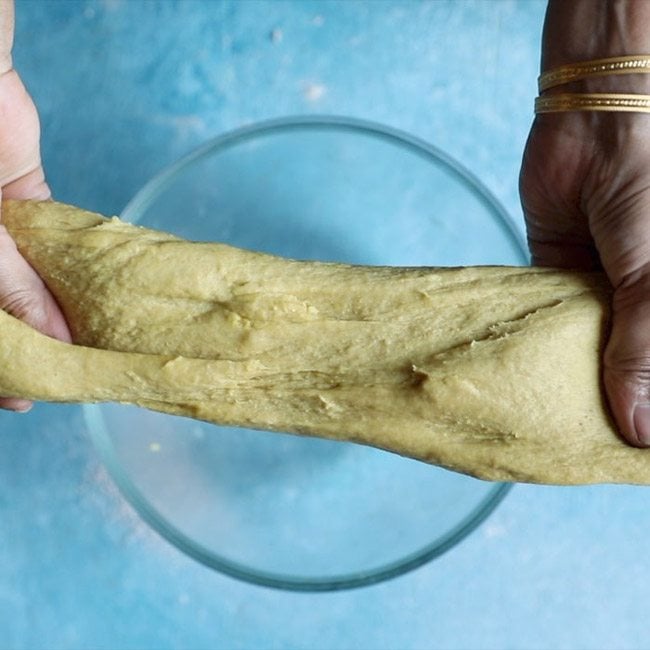
8. Cover and keep aside. Let the dough rest for 30 minutes. You can spread some oil all over the dough also and then cover the bowl.
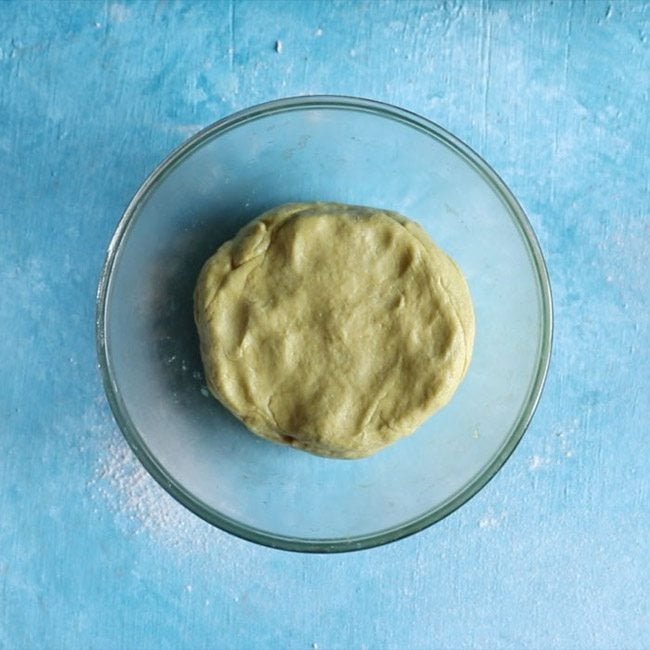
Cook Lentils
9. While the dough is resting, you can start with the sweet stuffing. Rinse and take 1 cup chana dal (hulled split bengal gram) in a 3 litre stovetop pressure cooker. Also, add 2.5 cups water.
If you want, you can even soak chana dal for an hour. You can also use toor dal (arhar dal, pigeon pea lentils) instead of chana dal.
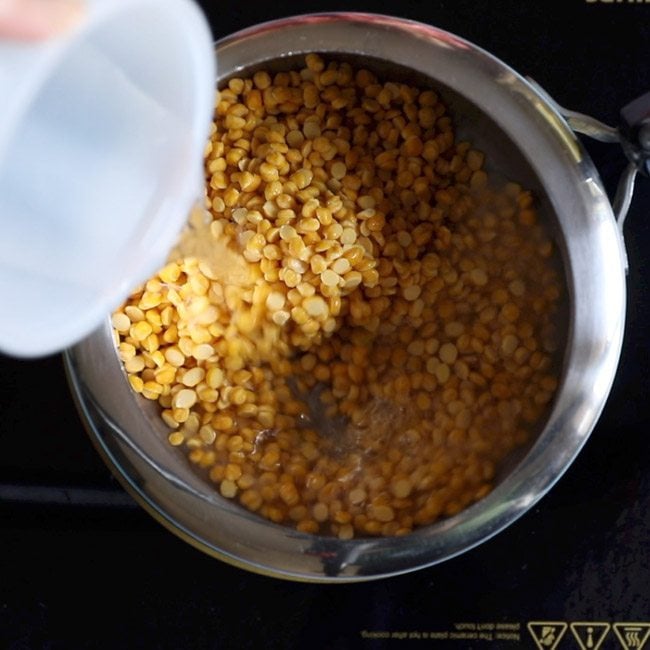
10. Pressure cook on medium heat for 6 to 7 whistles.
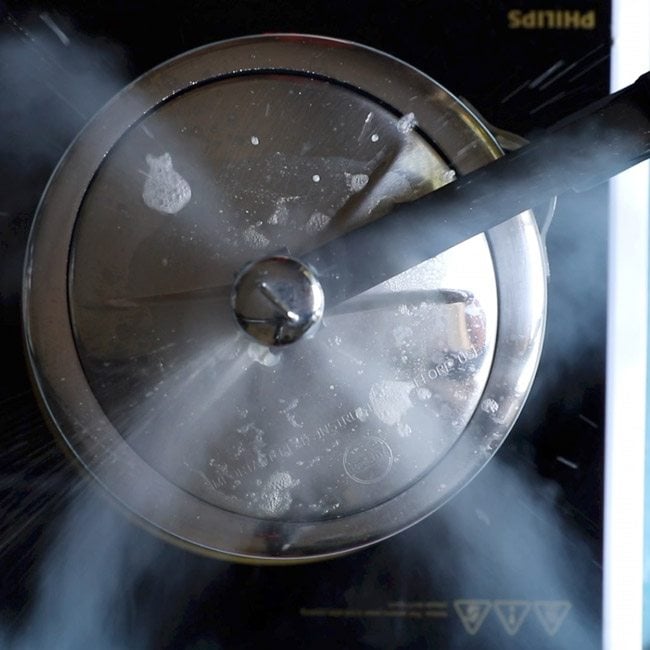
11. When the pressure settles down naturally, open the lid of the cooker and check if the chana dal is cooked well.
Take a few chana dal grains and mash with your fingers. They should get mashed easily. Take care as the lentils will be very hot.
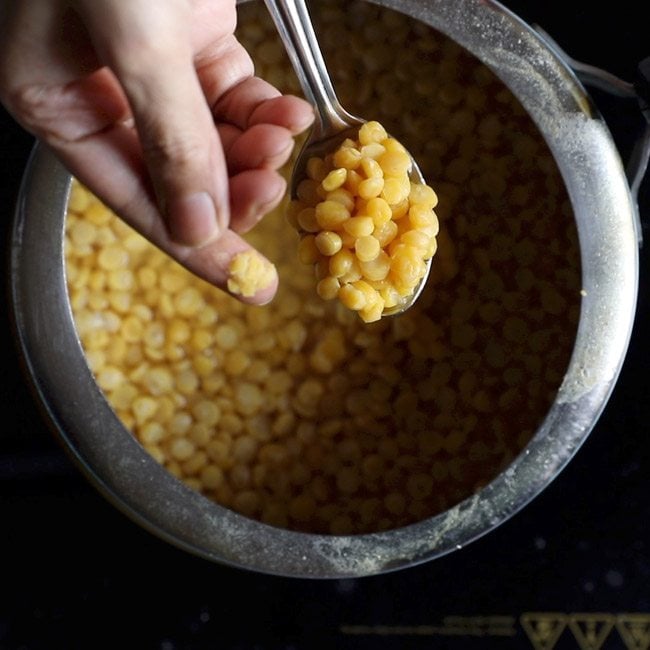
12. Strain the chana dal lentils and let them cool or become warm.
Use the strained water for making Rasam or Katachi Amti. You can also knead chapathi dough with this water or add it to curries or dals.
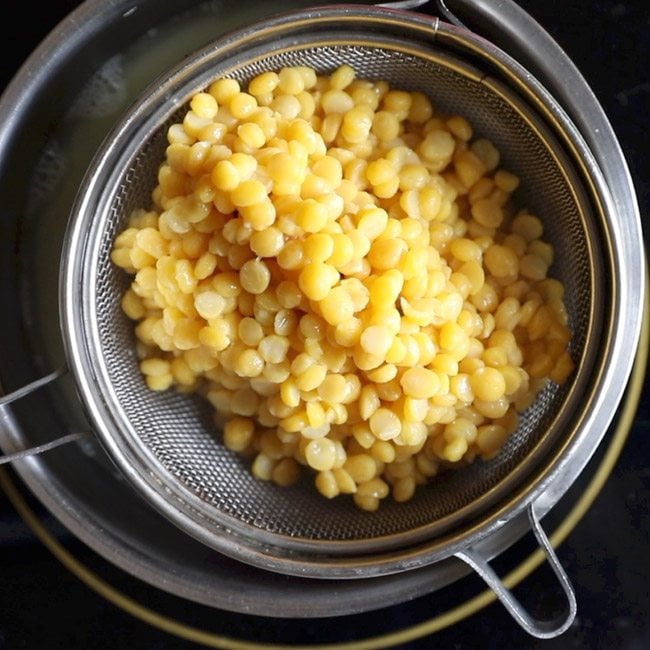
Blend Stuffing Ingredients
13. Then, add the cooked chana dal in a mixer or grinder jar.
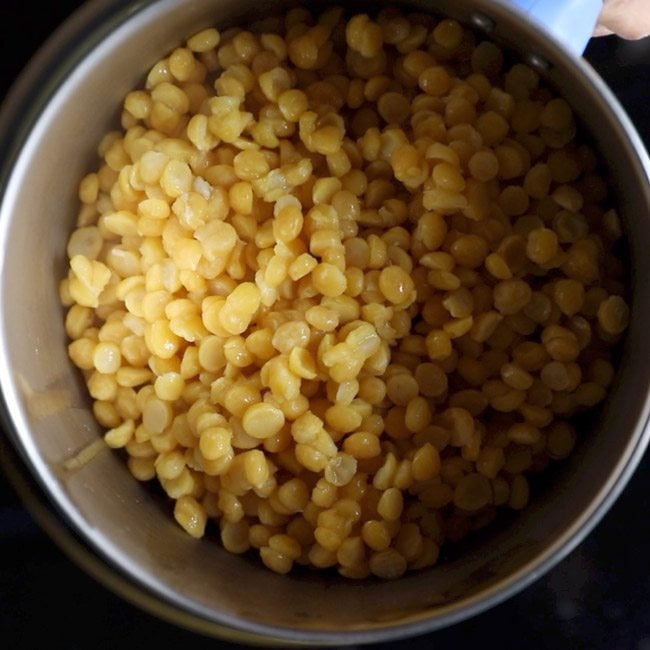
14. Add 1 cup chopped jaggery, ½ teaspoon green cardamon powder and ¼ teaspoon nutmeg powder.
I have used organic jaggery and hence not dissolved in water and then strained it.
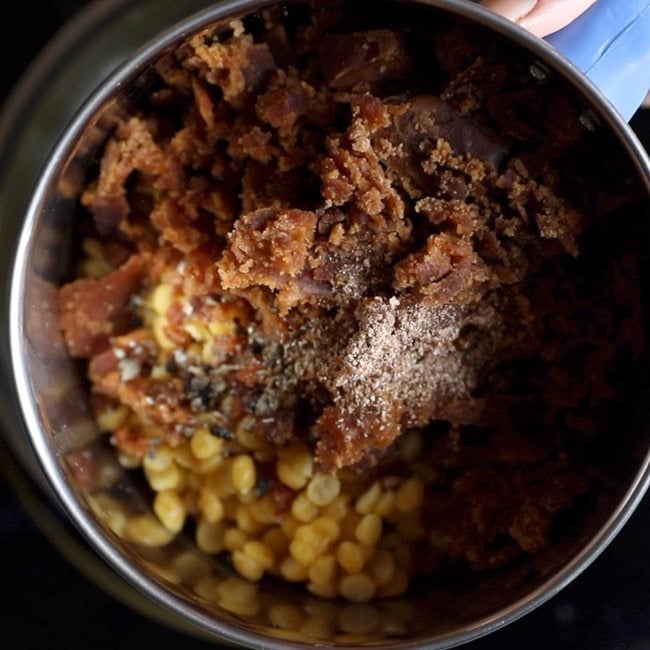
15. Grind or blend to a fine and smooth consistency.
If you are unable to grind, then add 2 to 3 tablespoons or more water as needed. Grind at intervals. Grind, then scrape the jar and grind again.
The entire chana dal mixture should have a smooth texture. No whole or part chana dal should be visible in the mixture.
Otherwise while rolling, the flatbread will break. Make sure to cook the chana dal well.
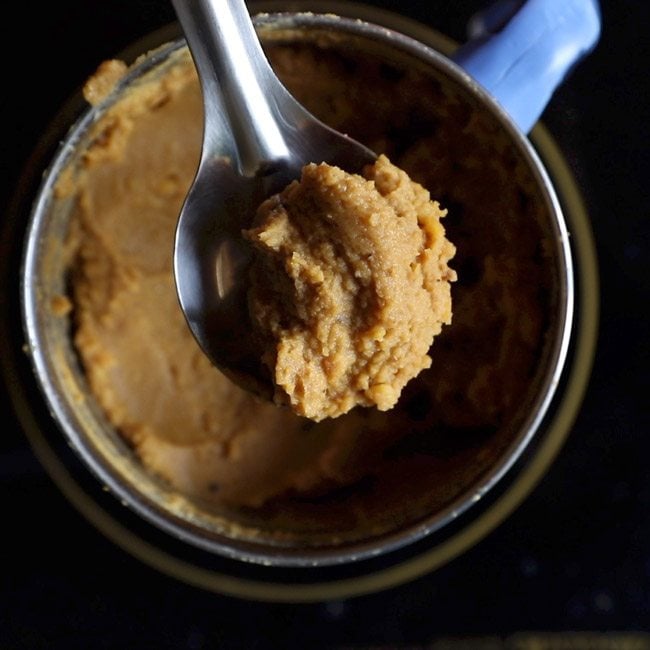
Cook Stuffing
16. Heat 1 tablespoon ghee in a pan.
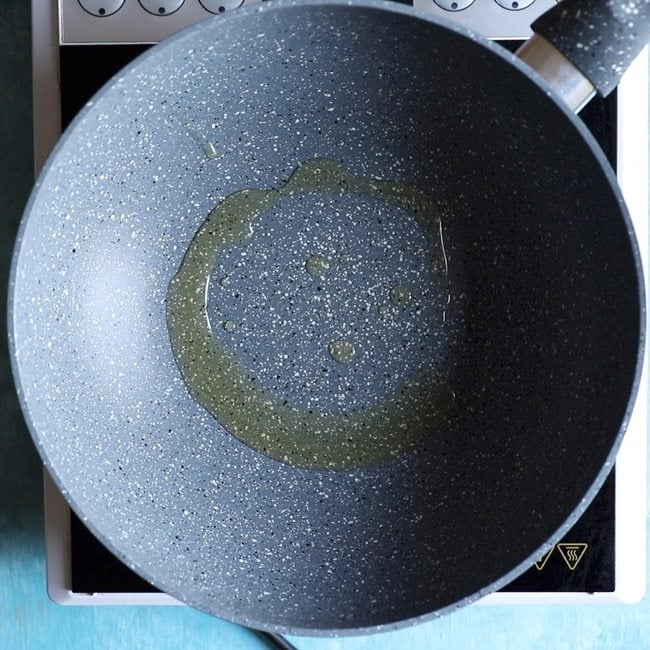
17. Add the prepared chana dal-jaggery mixture.
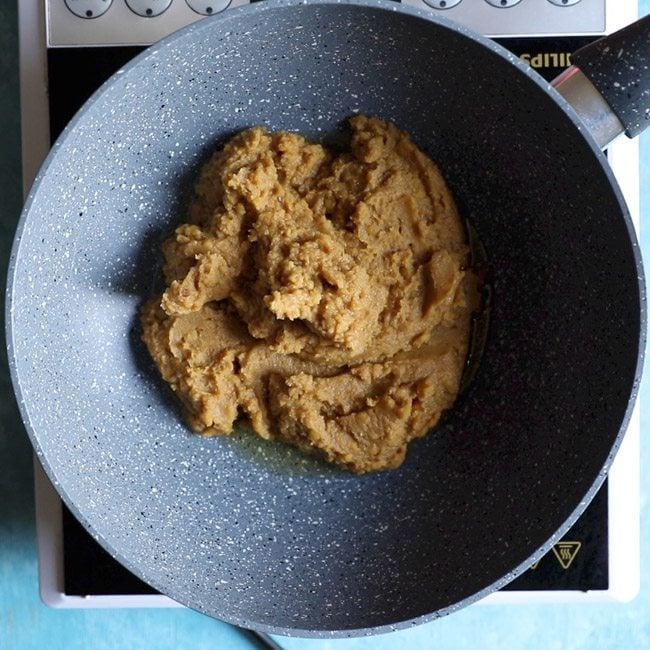
18. On low heat, stirring continuously, cook the mixture till it starts to leave the edges of the pan.
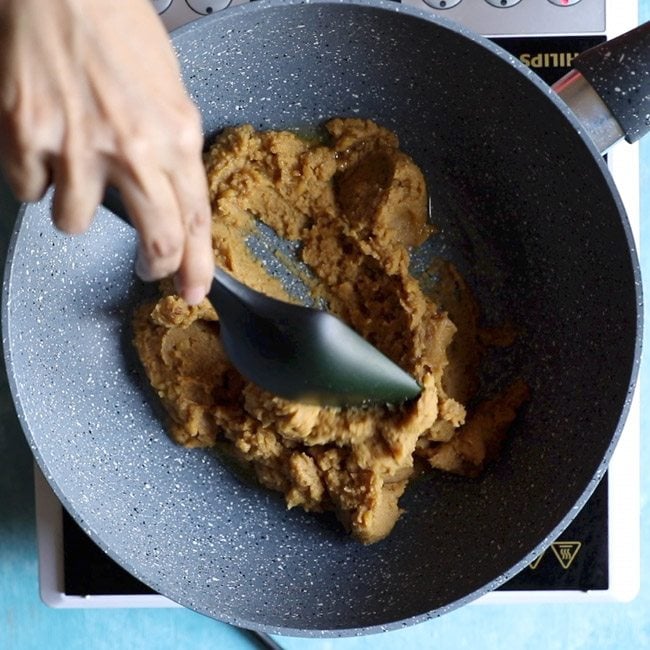
19. Then, turn off the heat and set aside. Let the stuffing mixture cool down.
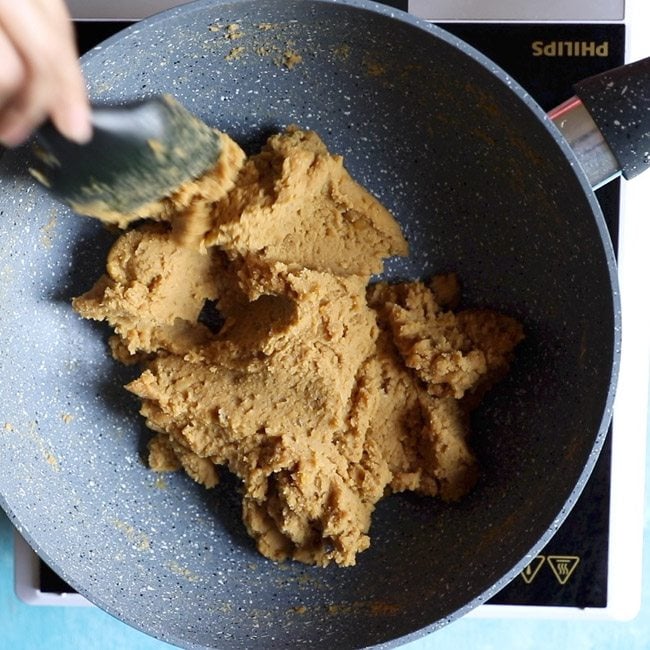
20. Make medium sized balls from the mixture and keep aside. Cover them so that they do not dry out.
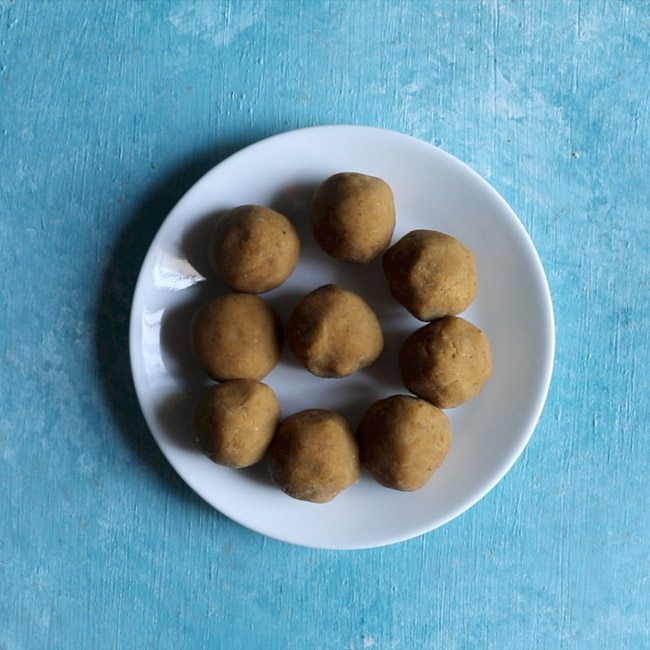
Assemble, Stuff and Shape
21. Pinch a medium sized ball from the dough. Roll to a neat ball.

22. Gently flatten it with your fingers. You can also use the rolling pin and flatten it.
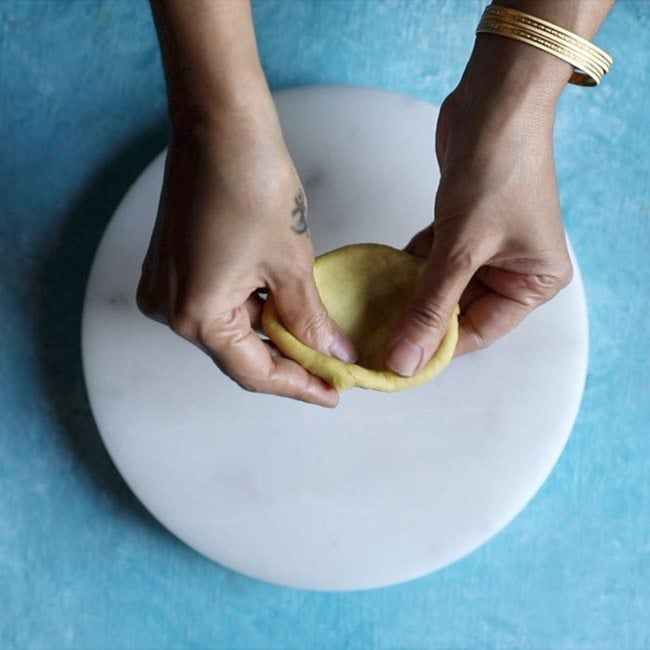
23. Place the chana dal stuffing ball in the flattened dough.
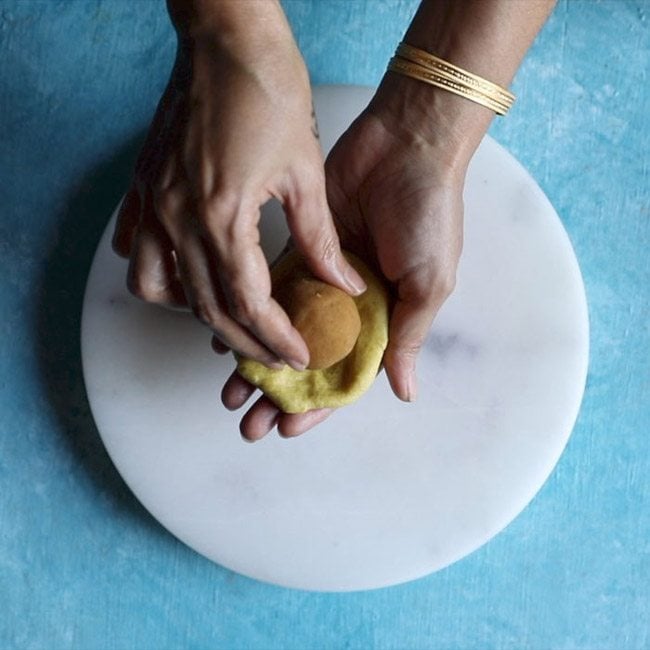
24. Then, begin to bring the edges together.
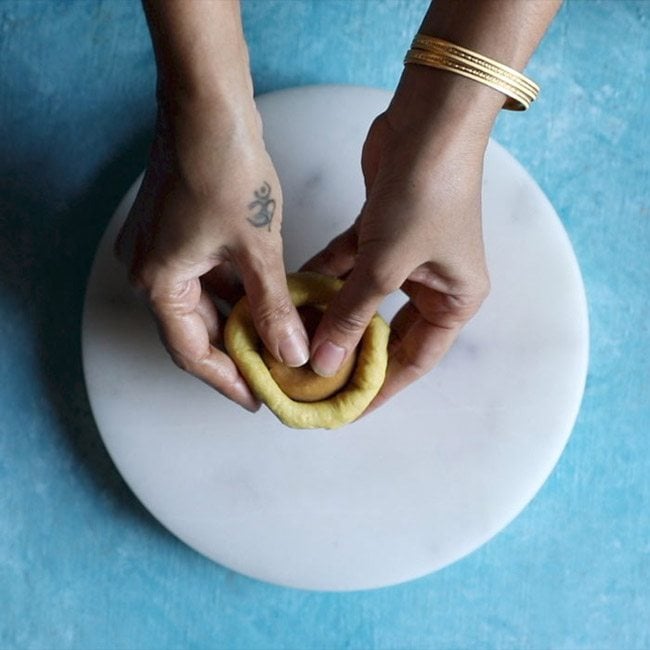
25. Press the edges at the center.
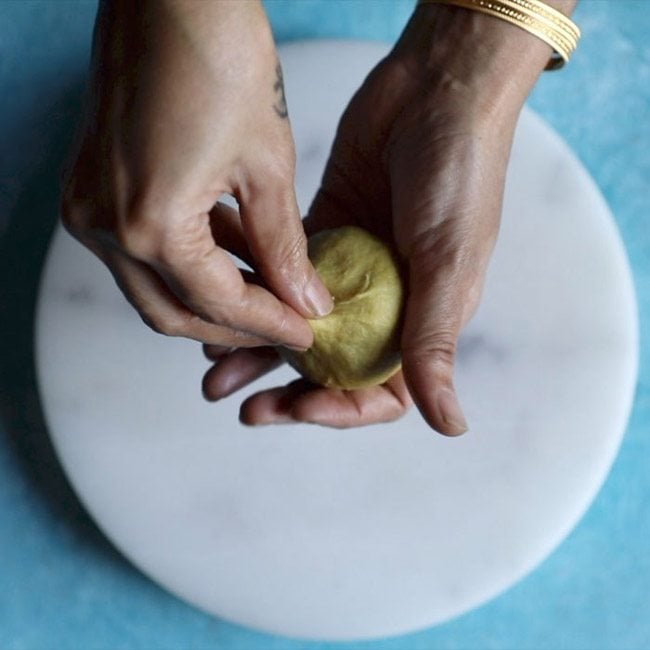
26. Then, flatten the center and gently roll the stuffed dough ball between your palms. To see the method of stuffing and sealing, do check the video embedded above.
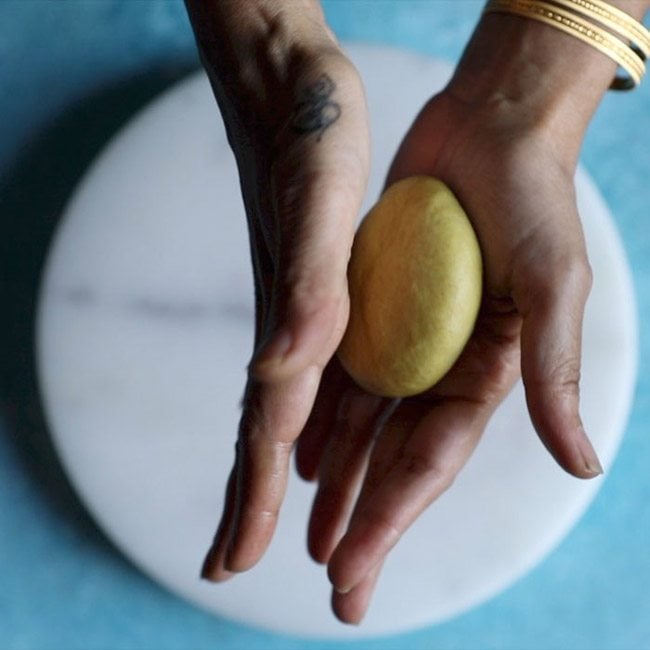
27. Stuff the dough balls this way and keep covered with a kitchen napkin, so that they do not dry out.

Roll Bobbatlu
28. Place the stuffed dough ball on rolling board and sprinkle some rice flour. Instead of rice flour, you can also use all-purpose flour for this Obbattu Recipe.

29. Gently roll to a large Holige. Add rice flour as required while rolling.

Cook Obbattu
30. Heat a tawa or flat skillet. Sprinkle some flour on the tawa and it should get golden (wipe off this flour). Then, gently place the Obbattu on the tawa.
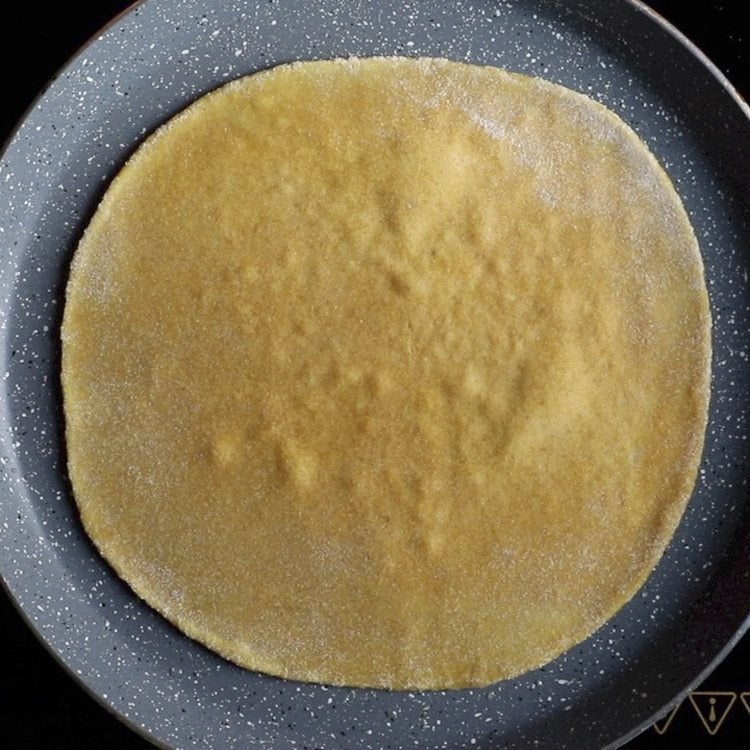
31. Roast the flatbread till one side is golden and then gently flip. If the stuffing and rolling is done well, the flatbread will puff up as you see in the photo below.
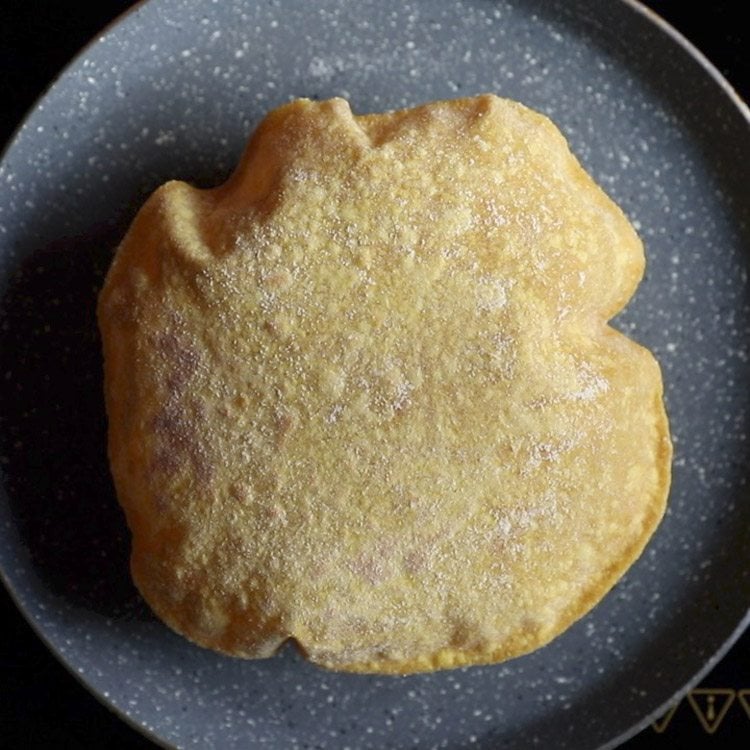
32. Spread some ghee or oil on this second side. You can skip adding ghee or oil in this Holige Recipe, if you prefer.
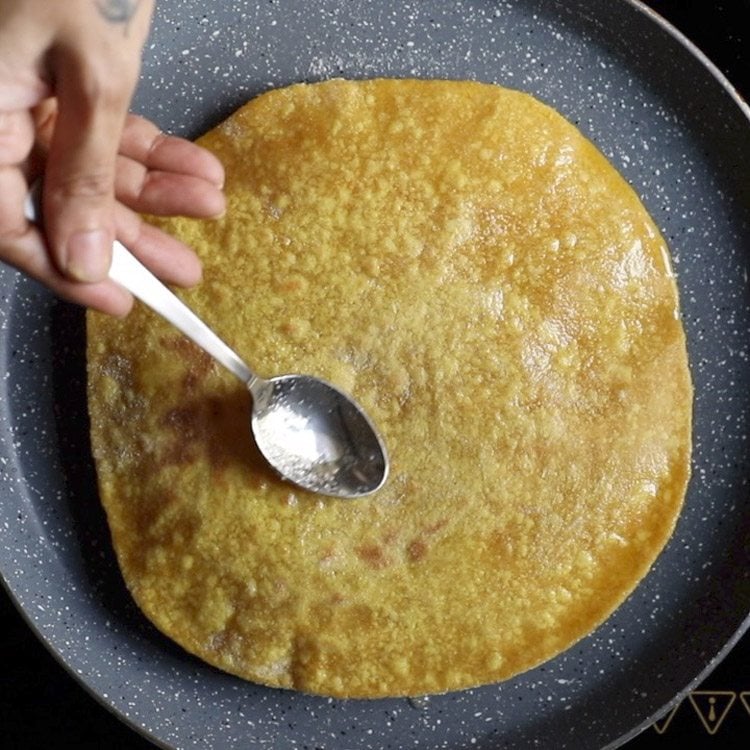
33. Flip again and roast the second side of the flatbread till golden.
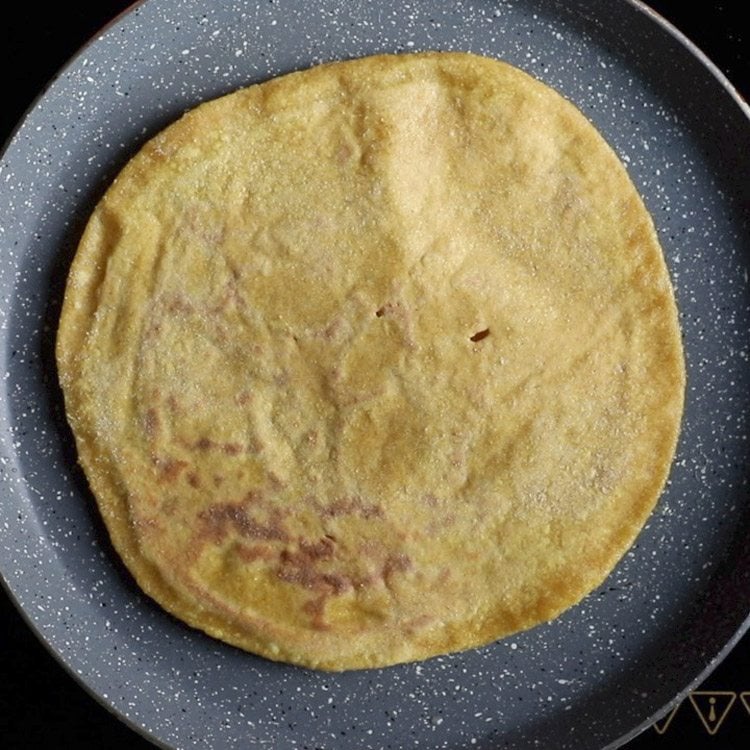
34. Spread some ghee or oil on this top side too that is facing you.
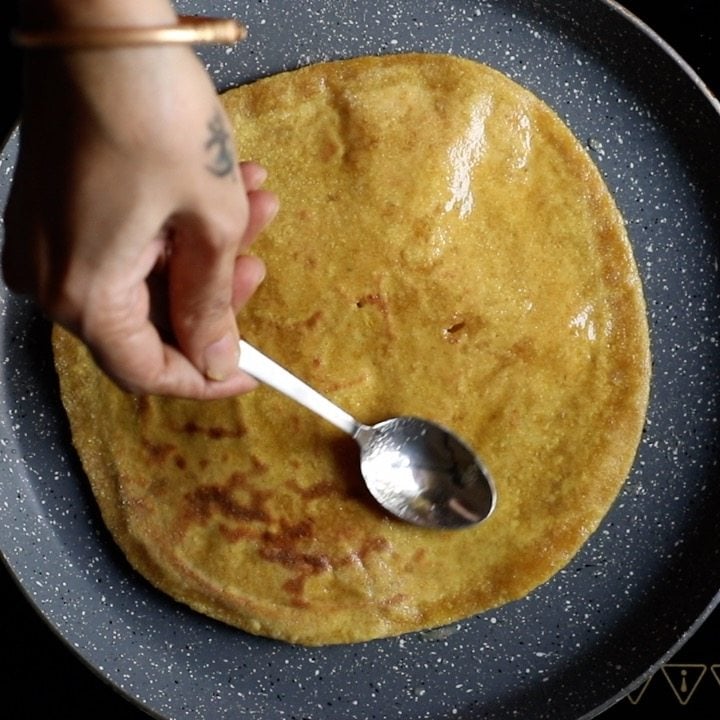
35. Fold and serve Bobbatlu with milk or ghee by the side, or have them plain. Or you can just lift and place them in a roti basket, so that they remain warm.
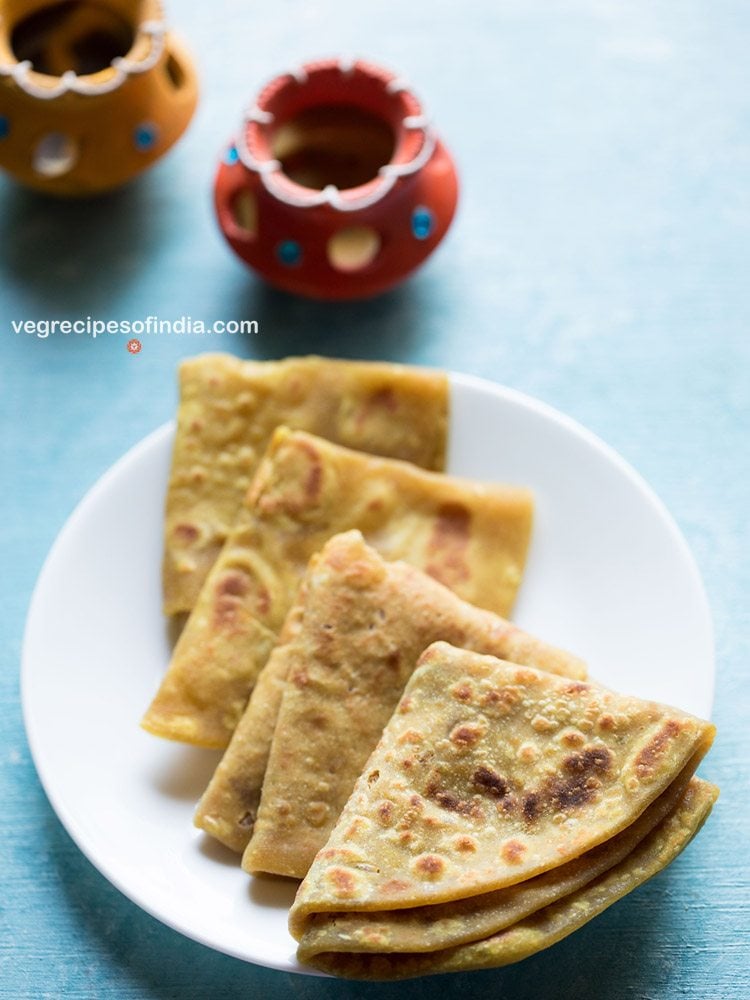
Expert Tips
- Make sure you are kneading a soft, smooth and elastic dough for this recipe. You have to spend some time kneading the dough very well. Do not be in a hurry.
- For the stuffing in this recipe, you can either use chana dal or tuvar dal (arhar dal). Basically use whatever lentils you prefer.
- Drain the water very well from the cooked lentils. Waterlogged lentils will make the filling mixture mushy and moist.
- You can even add some freshly and finely grated coconut in the stuffing.
- Sugar can also be used as a sweetener for the stuffing, instead of jaggery. Other alternatives are palm jaggery and coconut sugar.
- While rolling, you can either use rice flour or all-purpose flour.
- To roast these flatbreads, you can either use oil or ghee (clarified butter), or just roast without any fat too.
More Festive Sweet Recipes To Try!
Sweets Recipes
Sweets Recipes
Sweets Recipes
Please be sure to rate the recipe in the recipe card or leave a comment below if you have made it. For more vegetarian inspirations, Sign Up for my emails or follow me on Instagram, Youtube, Facebook, Pinterest or Twitter.
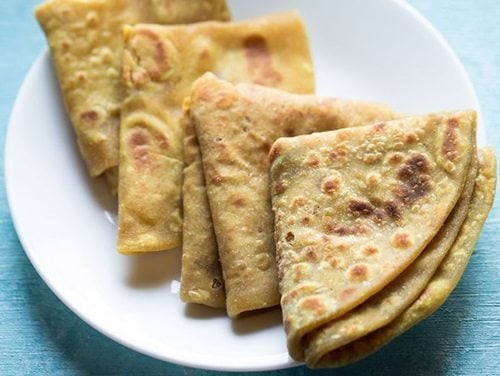
Bobbatlu Recipe | Obbattu Recipe | Holige Recipe
Ingredients
For the dough
- 1 cup whole wheat flour (atta)
- 1 cup all-purpose flour (maida)
- 4 to 5 tablespoons oil or ¼ cup oil or ghee
- ½ teaspoon salt
- ¼ teaspoon turmeric powder (haldi)
- ⅓ cup water or add as required
- ghee or oil for roasting, as required
For the stuffing
- 1 cup chana dal – 195 grams (split and husked bengal gram)
- 2.5 cups water – for pressure cooking
- 1 cup jaggery – 160 to 165 grams
- ½ teaspoon green cardamom powder
- ¼ teaspoon nutmeg powder or grated nutmeg – optional
Instructions
Making dough
- In a sieve, take the whole wheat flour, all-purpose flour, turmeric powder and salt.
- Sift and set aside.
- Add about ⅓ cup water and knead lightly. Do add water as required.
- Then add 5 tablespoons oil and continue to knead.
- Knead till all the oil is absorbed. Basically you will have to knead for about 7 to 8 minutes till all the oil is absorbed and the dough becomes very soft and pliable. Do add more water if needed.
- The obbattu dough should be kneaded very well to get a smooth, soft and elastic texture.
- Cover and keep aside. Let dough rest for 30 minutes.
Making obbattu stuffing
- Rinse a few times in water and then take the chana dal in a 3 litre stovetop pressure cooker. If you want you can even soak chana dal in water for 1 hour.
- Next add 2.5 cups water. Pressure cook for 6 to 7 whistles on medium heat.
- When the pressure drops naturally in the cooker, then only open the lid of the cooker and check if the chana dal is cooked well.
- Take a few lentils and mash it with your fingers. They should get mashed easily. Do take care as the lentils will be very hot.
- Strain the chana dal very well and let the lentils cool or become warm.
- Then add the chana dal in a blender or grinder jar.
- Add the chopped jaggery, green cardamon powder and nutmeg powder or grated nutmeg.
- Grind or blend to a smooth and fine consistency. If you are unable to grind, then you can add 2 to 3 tablespoons or more water. Grind at intervals.
- Grind, then scrape the jar and grind again. The entire chana dal mixture should have a fine and smooth texture. No chana dal should be visible in the stuffing. Otherwise while rolling, the obbattu breaks. So do make sure to cook the chana dal well.
- Next heat 1 tablespoon ghee in a pan.
- Add the ground chana dal and jaggery mixture.
- On a low heat stirring non-stop cook the mixture till it starts to leave the edges of the pan.
- Then turn off the heat and keep aside. Let the stuffing mixture cool down.
- Make medium sized balls from the mixture and set aside. Cover them so that they do not dry out.
Stuffing and rolling obbattu or bobbatlu
- Pinch a medium sized ball from the dough. Gently flatten it with your fingers. You can also use the rolling pin and flatten it.
- Place the chana dal stuffing ball in the flattened dough.
- Bring together the edges and press them at the center.
- Then flatten the center and gently roll the stuffed dough ball between your palms. To see the method of stuffing and sealing, do check the video embedded above at the top of the page. Stuff the dough balls this way and keep covered with a kitchen napkin, so that they do not dry out.
- Place the stuffed dough ball on rolling board and sprinkle some rice flour. Instead of rice flour you can also use all purpose flour for dusting.
- Gently roll to a large obbattu. Add flour as required while rolling.
Cooking obbattu or bobbatlu or holige
- Heat a flat skillet or tawa. Sprinkle some flour on the tawa and it should get golden (wipe off this flour). Then gently place the obbattu on the tawa.
- Roast till one side is golden and then flip.
- Spread some ghee or oil on this roasted side. You can skip adding ghee or oil if you like.
- Flip again and roast the second side till golden.
- Spread some ghee or oil on this second side too.
- If needed for even roasting and cooking, you can flip a few times.
- Fold and then serve obbattu. Or you can just lift them and place them in a roti basket, so that the obbattu remain warm.
- Serve Bobbatlu or Obbattu with milk or ghee by side. Or you can just have them as is.
Video
Notes
- You can use oil instead of ghee while roasting.
- Instead of chana dal, you can use tuvar dal (arhar dal).
- Some finely grated fresh coconut can also be added in the stuffing.
- Instead of jaggery you can use sugar, palm jaggery (or palm sugar) and coconut sugar.
- Use the lentil strained water for making rasam or soups. You can also knead your roti or chapathi dough with this water or add it to curries or lentil or rice based dishes.
Nutrition Info (Approximate Values)
This Bobbatlu recipe from the archives was first published on March 2017. It has been updated and republished on March 2023.
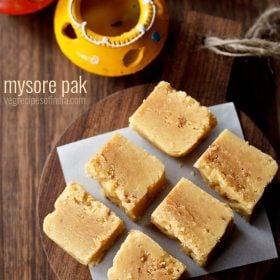
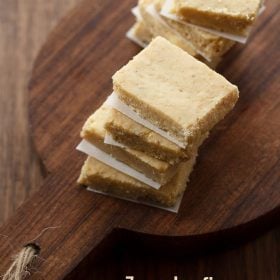
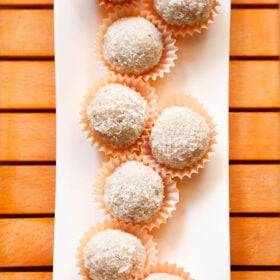
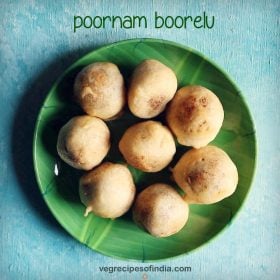
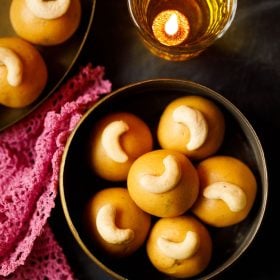
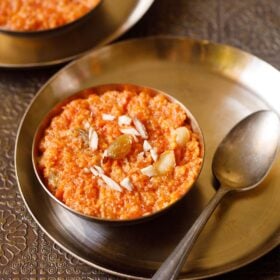
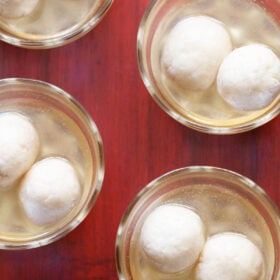
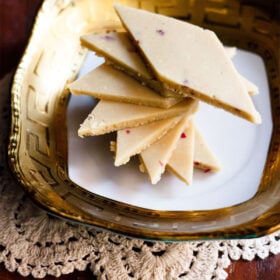








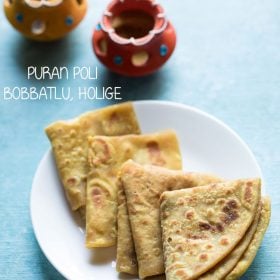
can I use two cups whole wheat flour instead of maida?
shilpa, yes you can use.
Hi Dassana
What brand of tawa have you used in the video?
reva, its a granite look non stick tawa from wonderchef brand.
I love obittu with KAYIHAALU but I m looking for dat recipe.. pls upload if u know.. I had only once at my friend’s house in my childhood.. 🙁
pooni, i will try to add that recipe.
Madam can you give the recipe for coconut holige pls.
nrimala, i plan to add coconut holige recipe in this festive season. so have taken your recipe request on file.
I have always had difficulty with holige, but following ur recipe came out perfect.. thank u
welcome shilpa
Ma’am thanks for your blog! However the Puran turned out soggy after grinding. Later I added some rice flour to make it thick and then continued the way you suggested. They turned out real good. Any idea why the puran turned soggy? Mistake with jaggery or channa dal?
okay. if the puran is cooked more, then the sogginess will go away. it needs to be cooked till it starts to leave the sides of the pan. i think its due to the chana dal being overcooked. but your idea of adding rice flour was a good one.
Ma’am, your blog is so good that I think you deserve a great respect for all your work here. You are very articulative and comprehensive about your recipes. You are just great. I pray for your good health and long life!
Thanks Anurag for your positive feedback and best wishes. Glad to read your comment.